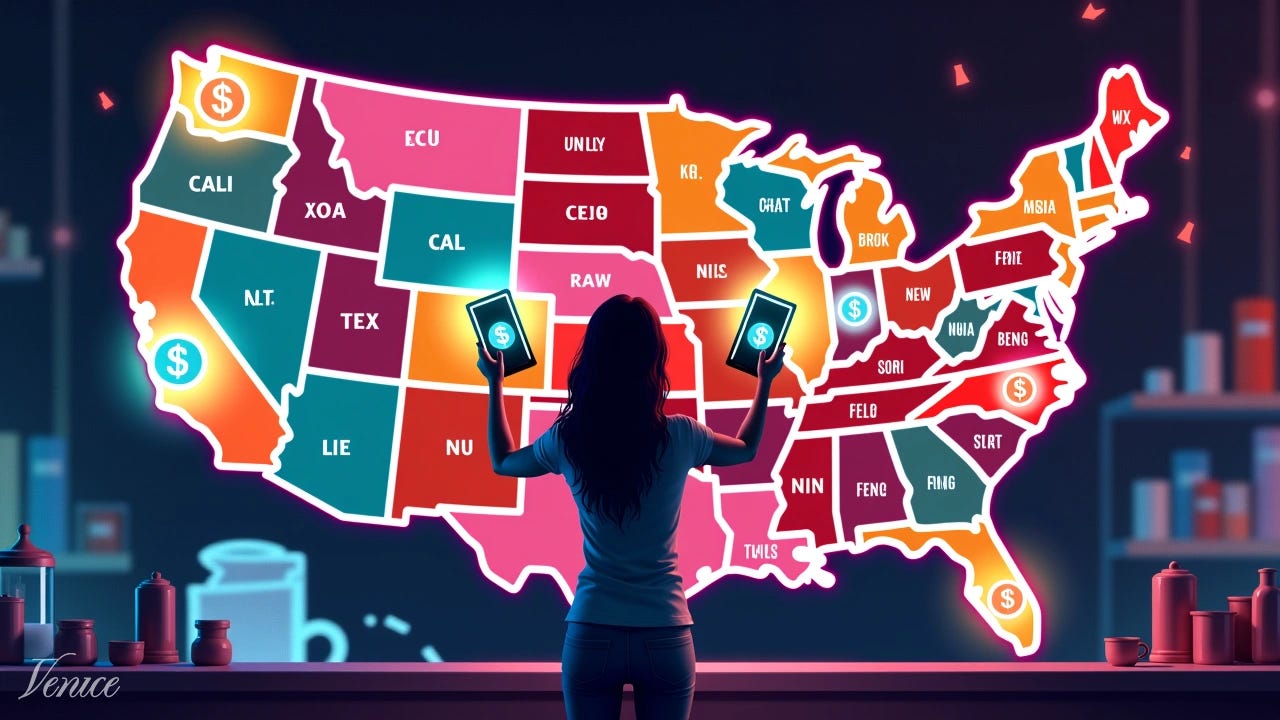Wyoming’s $WYST Stablecoin: Could a State-Backed Crypto Change the Game—or Stir Chaos?
Unveiling Wyoming’s $WYST Stablecoin: A Game-Changer or Financial Chaos Waiting to Happen?
Disclaimer: This article is for informational purposes only and should not be considered financial advice. Always consult with a professional financial advisor before making any investment decisions.
What if a single U.S. state could rewrite the rules of money with a digital coin? Picture this: a small business owner in Cheyenne, Wyoming, named Maria, who runs a cozy coffee shop called Brewed Awakening. She’s tired of hefty credit card fees eating into her profits, so she starts accepting a new digital token called $WYST—launched by her home state. It’s fast, fees are next to nothing, and her customers love the novelty. But then, a rumor spreads online: what if Wyoming’s bold move sparks a domino effect, and every state starts issuing its own digital cash—leading to a fractured financial system?
“The future of finance is on-chain, but it’s a double-edged sword,” says Vitalik Buterin, Ethereum’s co-founder, in a 2024 blog post.
Let’s unpack Wyoming’s $WYST stablecoin, explore its mechanics, and dive into the messy debates it’s sparking.
The Basics: What’s $WYST and Why’s Wyoming Doing This?
Wyoming, a state known for wide-open plains and a fierce independent streak, just made history by launching $WYST—the first fully-reserved, fiat-backed stablecoin issued by a U.S. public entity. Announced on May 14, 2025, by Cointelegraph, $WYST is pegged to the U.S. dollar and backed by solid assets like cash and U.S. Treasury bonds. The goal? To create a digital currency that’s as stable as the dollar but moves at the speed of crypto—think instant global payments with fees so low they’re practically a rounding error (oops, almost said the fees were “seamless”—let’s just say they’re tiny).
The Wyoming Stable Token Commission, a group of financial and tech experts, is behind this project. They partnered with LayerZero, a tech firm that makes blockchains play nice together, to roll out $WYST across multiple networks like Ethereum, Solana, and Avalanche. Why Wyoming? The state’s been a crypto pioneer for years, passing laws that make it a haven for blockchain businesses.
“Wyoming is showing the world how to blend tradition with the future,” notes Caitlin Long, founder of Custodia Bank, in a 2023 interview with Forbes.
But the bigger question is: how does this actually work for someone like Maria, the coffee shop owner?
Maria’s first $WYST transaction happens on a sunny Tuesday. A tourist from Japan, sipping her latte, pays with $WYST using a crypto wallet on her phone. The payment zips through Solana’s network in seconds, costing Maria less than a penny in fees. Compare that to the 3% she’d lose on a credit card payment—she’s thrilled. But $WYST isn’t just about small businesses. It’s aiming to bridge the gap between old-school finance and the wild world of crypto, making things like cross-border payments or decentralized finance (DeFi) apps more accessible.
How $WYST Works: A Peek Under the Hood
Let’s get into the nuts and bolts of $WYST without making your eyes glaze over. At its core, $WYST is a stablecoin—a type of cryptocurrency designed to hold a steady value. Unlike Bitcoin, which can swing wildly, $WYST is tied 1:1 to the U.S. dollar. For every $WYST token out there, Wyoming holds at least that much in reserves, mostly in U.S. Treasuries and cash. This setup, called over-collateralization, means there’s more value backing the tokens than the tokens themselves—kind of like a safety cushion.
The tech side is where things get interesting. $WYST isn’t stuck on one blockchain; it’s built to hop between networks like Ethereum, Solana, and Avalanche, thanks to LayerZero’s tech. A BeInCrypto article from March 26, 2025, explains: “Wyoming partners with LayerZero to launch the WYST stablecoin in July, pegged to the US dollar using cash, Treasury bonds, and repurchase agreements.” This cross-chain magic lets $WYST work wherever it’s needed—Ethereum for big institutional players, Solana for speedy retail transactions, and Avalanche for eco-conscious folks who care about energy use.
Here’s a quick breakdown of the blockchains $WYST uses, based on data from the Wyoming Stable Token Commission’s testing phase:
For Maria at Brewed Awakening, this means she can accept $WYST on Solana for fast, cheap payments, while a big corporation might use Ethereum for a high-stakes deal. But the real kicker is how $WYST could change public finance. Wyoming might let residents pay taxes with $WYST, or even use it to settle state contracts—streamlining processes that usually take days.
“Stablecoins are the bridge we’ve been waiting for—they bring crypto’s speed to the dollar’s stability,” says Hester Peirce, an SEC Commissioner known as “Crypto Mom,” in a 2024 speech at a blockchain conference.
But not everyone’s cheering. Some worry that a state-backed stablecoin could shake up the financial system in ways nobody’s ready for.
The Controversy: What If Every State Jumps In?
Here’s where things get spicy. Wyoming’s $WYST is a first, but what if it’s not the last? Imagine a future where all 50 U.S. states launch their own stablecoins—California with $CALI, Texas with $TEX, Florida with $FLOR. Each state’s coin has its own rules, its own backing, its own quirks. Maria’s coffee shop in Wyoming accepts $WYST, but a tourist from California wants to pay with $CALI. Suddenly, Maria’s juggling exchange rates, blockchain fees, and maybe even state-to-state taxes. It’s a mess.
This “what if” scenario is already sparking debates online. On X, users like @kolin_ai celebrated Wyoming’s move, saying, “This is why we need more cowboys in crypto, less suits in DC.” But others, like @CatGodSandHive in a separate thread, aren’t so sure, sarcastically noting, “Oh great, another government coin to ‘fix’ things.” The fear is real: a patchwork of state-backed stablecoins could fragment the U.S. financial system, making it harder for businesses to operate across state lines.
Then there’s the federal angle. The U.S. government hasn’t passed a clear stablecoin law yet, though a CoinMarketCap article from January 3, 2025, points out: “Stablecoins are reshaping financial systems and unlocking new opportunities for innovation.” Wyoming’s acting on its own, but what happens if the feds step in with heavy regulations? Could $WYST get shut down—or worse, could it trigger a regulatory crackdown on all crypto?
“The lack of federal clarity on stablecoins is a ticking time bomb,” warns Sheila Warren, CEO of the Crypto Council for Innovation, in a 2025 interview with CoinDesk.
Maria, our coffee shop owner, doesn’t think about this stuff much—until a customer mentions the rumor about other states. She starts wondering: will $WYST make her life easier, or will it turn her simple business into a regulatory headache?
The Bigger Picture: Stablecoins and the Future of Money
Zoom out for a second. $WYST isn’t just about Wyoming—it’s a glimpse into where money might be headed. Stablecoins like $WYST are already huge in crypto, with billions of dollars in daily transactions. A chart from Statista (2025) shows that stablecoin transaction volume hit $1.2 trillion in Q1 2025, up 30% from last year. They’re used for everything from paying for coffee (like Maria’s customers) to settling international trades without the hassle of banks.
But $WYST adds a new twist: it’s state-backed. That gives it a layer of trust private stablecoins like Tether (USDT) or Circle (USDC) can’t match. Tether, for example, has faced years of scrutiny over its reserves, with a 2021 fine from the Commodity Futures Trading Commission for “making untrue statements” about its backing. $WYST, backed by Wyoming’s government and audited publicly, sidesteps that drama.
“A state-backed stablecoin could set a new standard for trust in crypto,” says Brad Garlinghouse, CEO of Ripple, in a 2025 tweet.
Still, the road ahead isn’t all smooth. Stablecoins have flopped before—remember TerraUSD in 2022? It was supposed to be stable but crashed hard, wiping out $40 billion in value. Wyoming’s over-collateralized reserves aim to avoid that fate, but nothing’s guaranteed. If $WYST stumbles, it could drag Wyoming’s reputation—and taxpayer money—down with it.
A Day in the Life: How $WYST Could Change Things
Let’s go back to Maria for a moment. A month after $WYST launches, she’s using it for more than just customer payments. She pays her coffee bean supplier in Brazil with $WYST, skipping the usual bank wire that takes three days and costs $30 in fees. The supplier, who’s on the Avalanche network, gets the payment in under two seconds for a nickel. Maria’s saving money, and her supplier’s happy—win-win.
But then she hits a snag. A new Wyoming law says businesses accepting $WYST get a tax break, but only if they report every transaction in detail. Maria’s not a tech whiz—she’s spending hours logging payments instead of baking her famous scones. It’s a reminder that $WYST, for all its promise, comes with growing pains.
“Technology moves fast, but human systems don’t,” observes Andreas Antonopoulos, a Bitcoin advocate, in a 2024 podcast episode.
On the flip side, Wyoming’s using $WYST to pay state contractors, cutting costs and speeding up projects. A small bridge repair in Cheyenne, for example, gets funded in $WYST, saving the state 2% on payment processing fees. If other states follow Wyoming’s lead, this kind of efficiency could ripple across the country—but so could the challenges.
Wrapping Up: A Brave New World or a Risky Experiment?
Wyoming’s $WYST is a bold step into uncharted territory. It’s a chance to rethink how money works—faster, cheaper, and more connected than ever. For Maria at Brewed Awakening, it’s already making a difference, even if the paperwork’s a hassle. But the bigger question lingers: is this the future of finance, or a Pandora’s box waiting to be opened? If every state jumps on the stablecoin bandwagon, the U.S. could end up with a fragmented system—or a revolution in how we pay for everything. “The line between innovation and chaos is razor-thin,” reflects Nouriel Roubini, an economist known for predicting the 2008 financial crisis, in a 2025 op-ed.
Poll time
Got a hot take? Drop a comment—what do you think $WYST means for the future of crypto?








